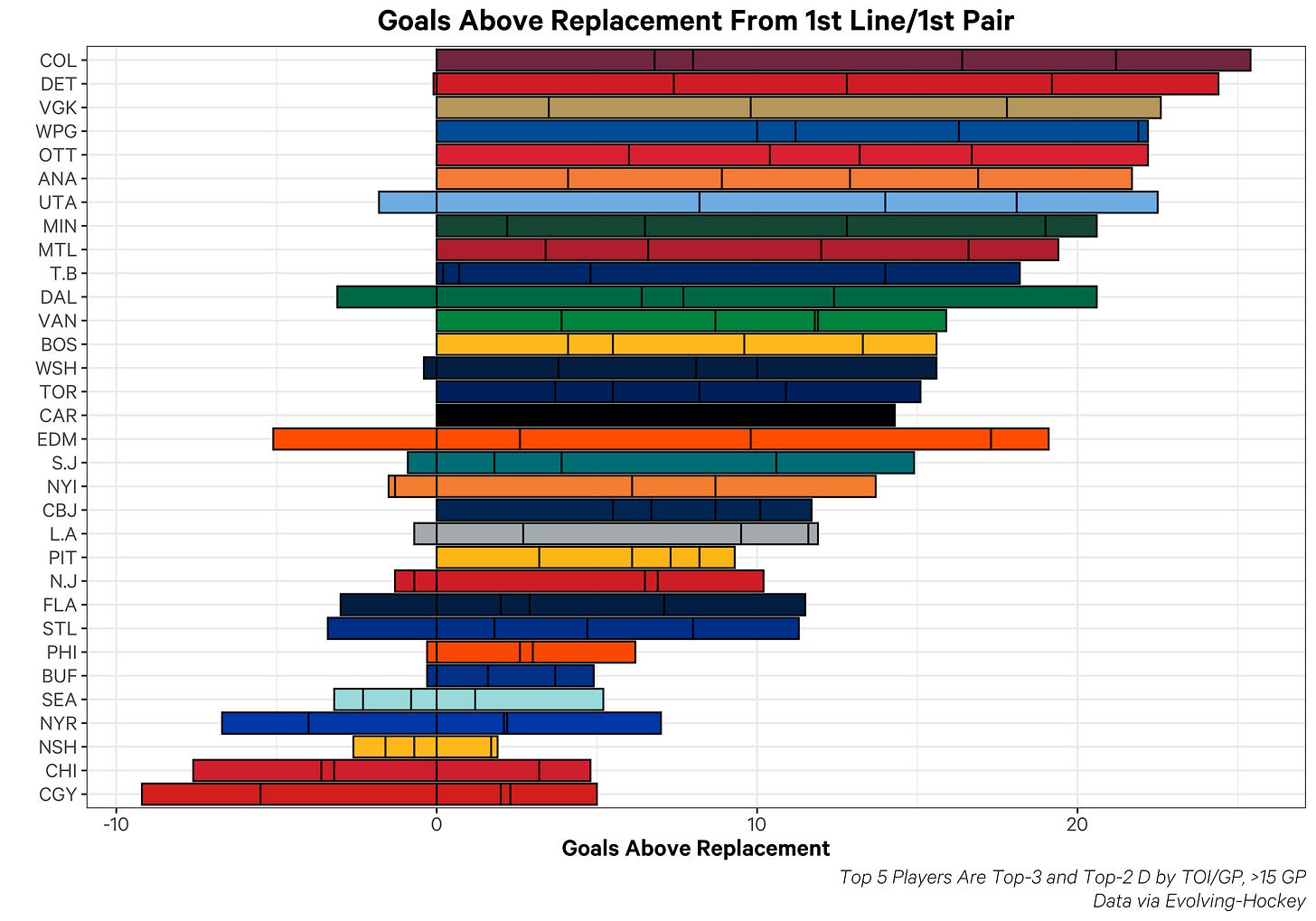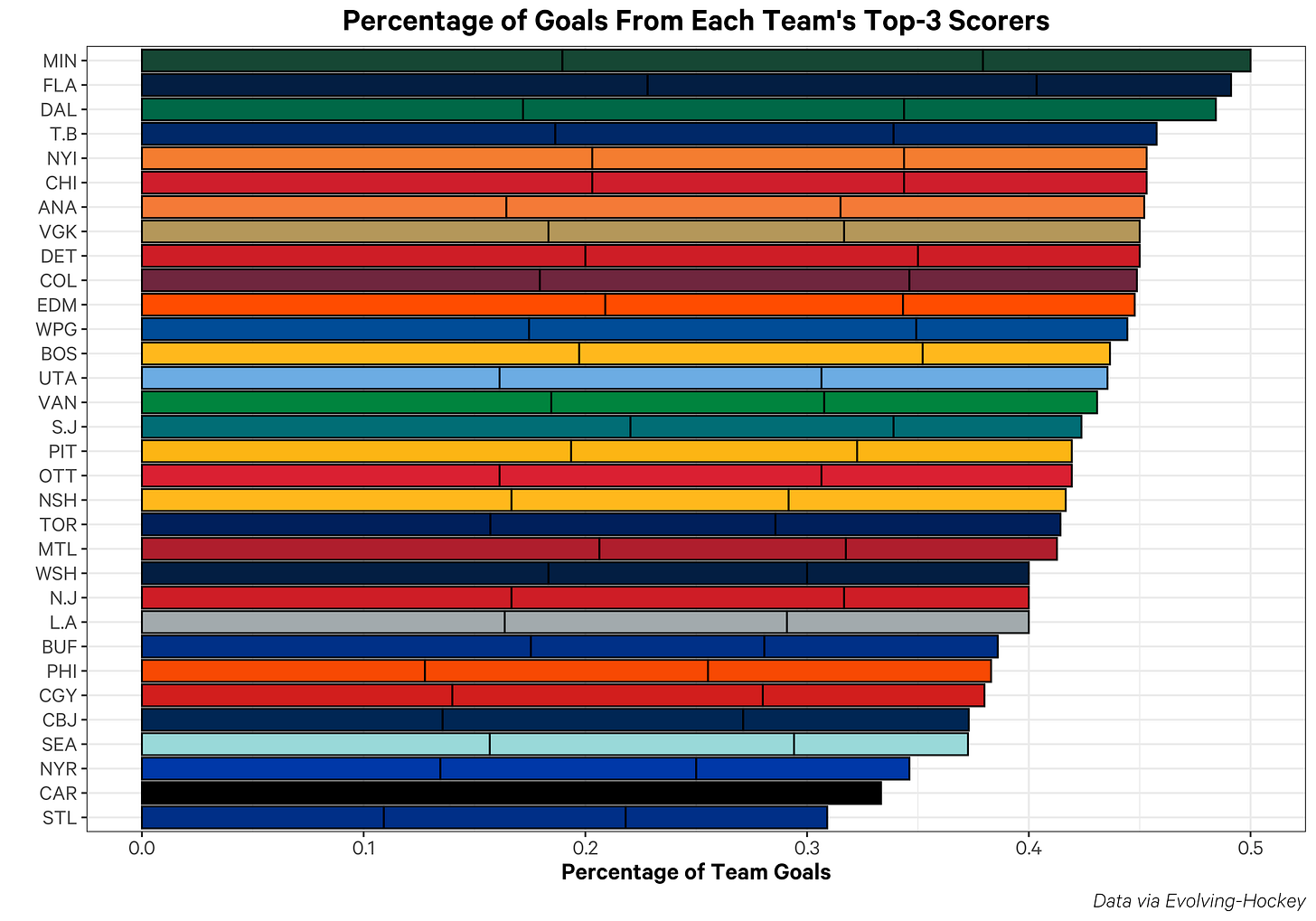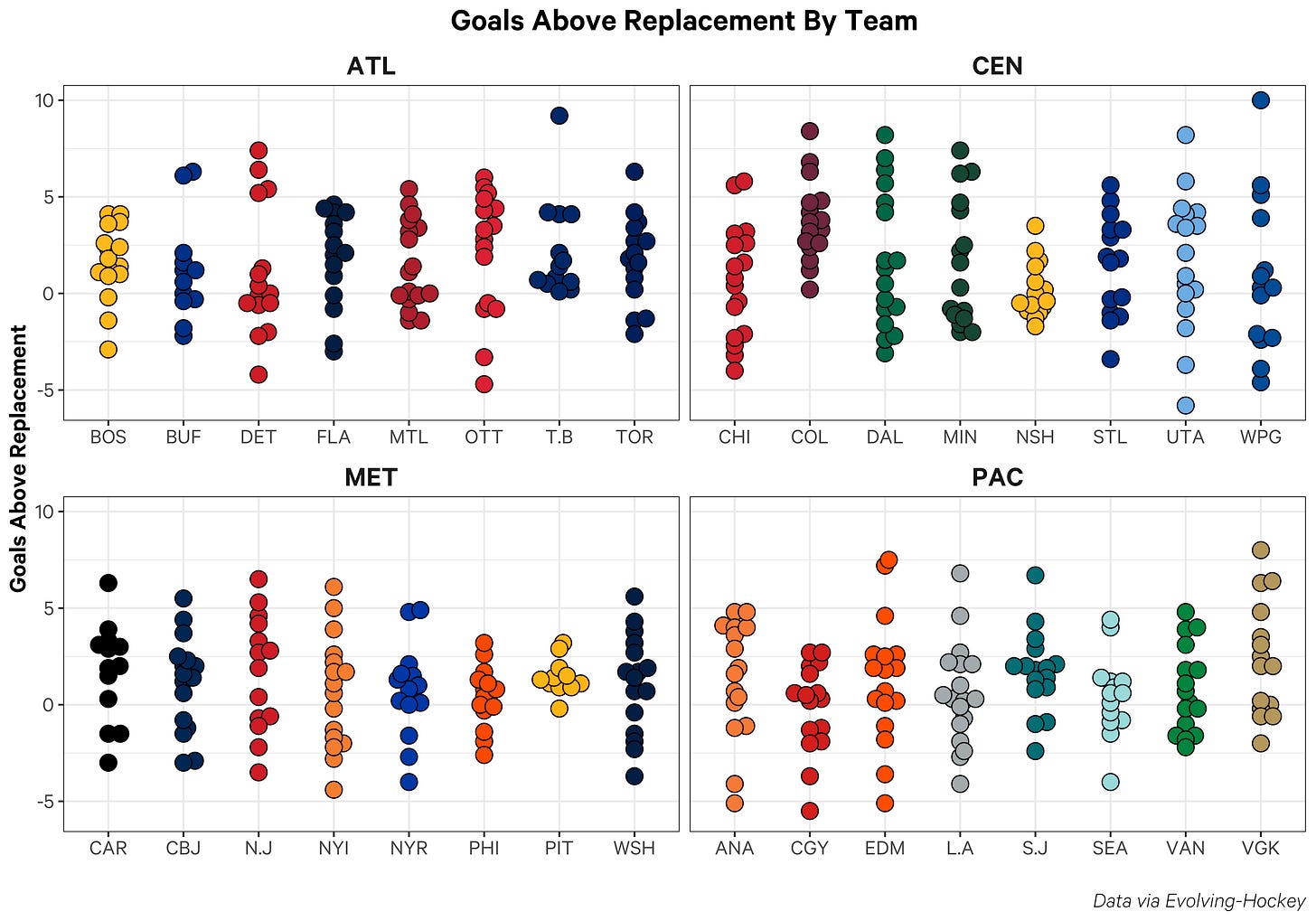Detroit’s “Core-4” Is Elite
The Rest? Not So Much
Through 20 games, the Red Wings sit atop the Atlantic Division with a 12-7-1 record despite facing a rather brutal October schedule. Taking a look at the Wings’ key metrics, the Wings have made significant improvements in the quality of chances they generate at 5v5 and the quality of chances allowed while shorthanded. This has helped the Wings overcome the drop-off in power play performance and 5v5 save percentage compared to last year.
When thinking about what’s worked for the Wings so far, The Athletic’s Max Bultman noted that the Wings’ star players have shown up in a big way. Dylan Larkin, Alex DeBrincat, and Lucas Raymond are all on pace for better than 90 points and Moritz Seider is garnering Norris Trophy consideration. When considering each team’s top three forwards and top two defensemen, only Colorado’s top-five players have contributed more value than Detroit’s thus far.
Furthermore, 45% of the Red Wings’ goals this year have come from the DeBrincat-Larkin-Raymond trio which ranks 9th in the league this year.
Unfortunately, as the Edmonton Oilers have demonstrated, being a top-heavy team can only carry you so far, particularly if you have aspirations of playoff success. There’s a lot of conversation around if hockey is a “strong-link” sport (having the best player on the ice gives you the best chance to win) or a “weak-link” sport (not having the worst player on the ice gives you the best chance to win), with compelling cases for both concepts. My personal bias is having the best player is great but it is quite difficult for a single player to “take over” a game compared to other sports as hockey players spend a smaller percentage of the game on the ice and do it in short shifts that are dependent on a number of factors out of the player’s control. Instead, I think a team’s depth is the key to winning games when it matters. As good as the Wings’ stars have been, the rest of the team has lagged behind.
From the plot above, we can see that Detroit’s stars are performing at an outstanding level, on par with top teams such as Colorado, Dallas, and Vegas. However, there is a sizable gap between the Wings’ “Core-4” and the rest of the team. Visually, they appear to be one of the most “imbalanced” teams in the league when it comes to the gap between their stars and the rest of the team. Ultimately the continued success of this team will come down to the following:
Can the Wings’ stars play at this elite level over the course of 82 games to overcome their lack of depth?
Can the Wings’ depth players step up in the event the Wings’ star players drop off from their elite level?
Given how the Wings have faltered in March each of the last two years, the condensed schedule with the Olympics, and the fact that three of the Wings’ stars will feature heavily in the Olympics, it is critical that the Wings’ depth step up to lessen the workload for the Wings’ star players.





Donated to the JDF today. Love your content! LGRW!
Option 1 feels fairly unsustainable - even if I rate their talent levels, so the question is how can option 2 work out.
I'm seeing a few paths forward for how the depth can 'step up' and was wondering if anyone may know some details to help add some odds to these outcomes. [Note: still deeply naïve about hockey advanced stats, so some of this may be effectively 'google it', and I'm going to us different metrics than GAR because...I don't have an Evolving Hockey account]
Path 1: Depth veterans revert to pre-Wings levels - In particular, do we see likely reversion candidates?
For instance using xSPAR[no idea if that's a good metric, but appears roughly related to my eye test] - Copp was a +2-4 player with the Jets and a minus player with the Wings. Notably he was +1 last year, which at least loosely matches my 'He was fine and things went off the rails when he got hurt' analysis. If Copp reverts to a slightly below average second and above average third liner, that takes some of the weight off the core 4. And Kane has only played about half the games thus far - and would be expected to be a positive xSPAR player(surprised to see he's only listed with .6 last year compared to 3.5 in 23-24).
However, to be a bit more nuanced - what would our expected reversion be based on their age curves? Ex. Is age 31 Copp expected to be neutral or could we expect him to return to being a slight positive? How much of an exception does Kane need to be for the same?
Path 2: Youth Development - Both rookies and other young players are obvious candidates for improvement. Based on your other article it appears Ed is a likely candidate, and is likely in the middle due to a rough start to the year. But otherwise the Wings have quite a youth movement - Finnie, Sandin-Pellikka, Kasper, Danielson, Edvinsson, Raymond, Soderblom, and Seider in the under 25 category and obviously MBN also made an appearance at the start of the year. [Not to mention our 3 25 year olds Johansson, JBD, and Berggren who may not have as much upside - but have plenty of mystery in their numbers] Seider and Raymond have obviously been hitting on that, while Kasper is having a sophmore slump. Will Finnie revert to his hot start? Stay where he's at? Tire out as the year goes by? And then the same for the rest of the crew?
The question underlying that - what do we see from other rookies and young players regarding their growth curve both across seasons (ex. Ed, Kasper, Soda) and within seasons(especially for rookies due to the 'figuring out the game' vs. 'tired by a long season' tropes)?
I could see it being likely that we see huge amounts of depth improvement from those 8 from added experience and understanding of the system, but could also see a later season drop off. So, to the extent we can add probabilities to those outcomes, that's great guidance on where the Wings need to be, do they need to add, etc.
Path 3: Acquisition - Need for which is influenced by the above 2 answers.
Obviously we can hope that everyone plays better in all ways, but I'm curious to better understand where it's a surprise if things get better and where we can, if not expect, at least look with some confidence. I'm still rather blown away by the youth movement in the team and am struggling to appropriately gauge what's a fair expectation of any of them.